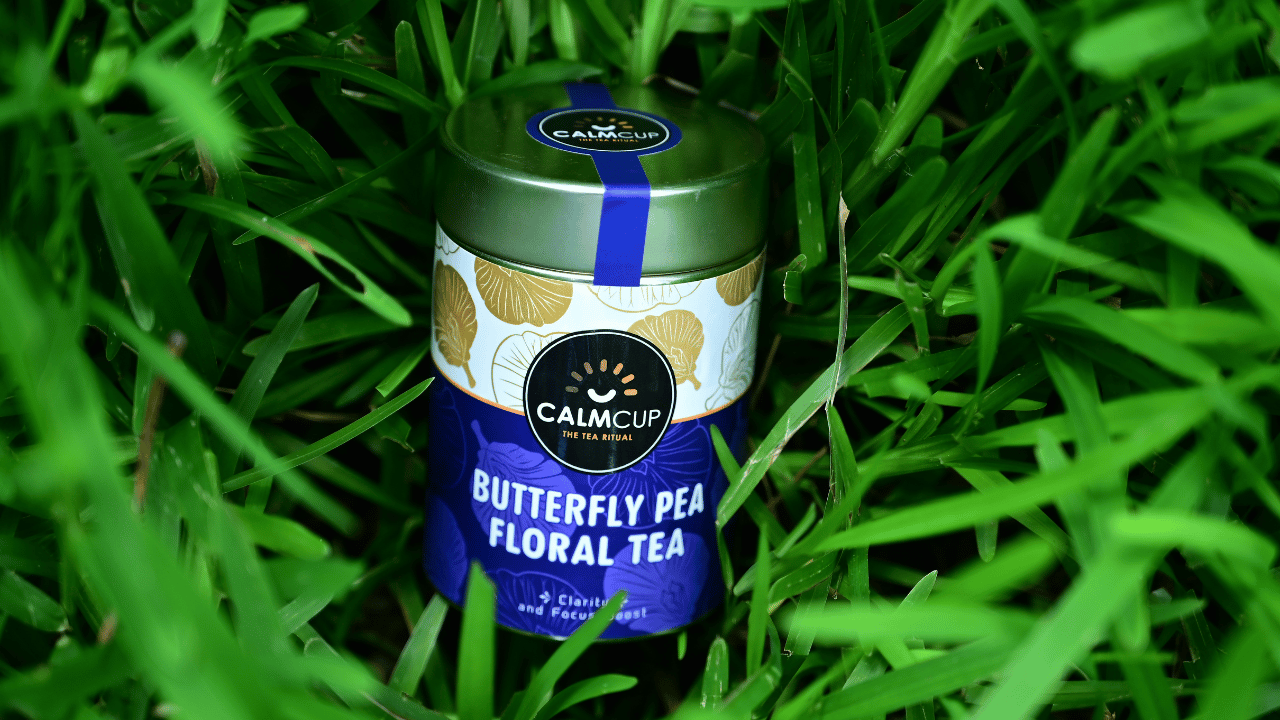Introduction
The world of herbal teas is as diverse as nature itself. From the calming notes of chamomile tea to the tangy kick of hibiscus tea, every herbal infusion brings its own flavour, health benefits, and cultural heritage.
And then there’s butterfly pea tea—a vibrant, colour-changing blue tea that’s fast becoming a wellness favourite.
At Calm Cup, we believe choosing the right herbal tea isn’t just about taste—it’s about how it fits into your lifestyle, mood, and wellness goals. In this guide, we’ll compare butterfly pea tea vs chamomile and butterfly pea tea vs hibiscus to help you pick the right sip for every occasion.
What is Butterfly Pea Tea?
Butterfly pea tea, also known as blue tea, is a caffeine-free herbal infusion made from the vivid blue petals of the Clitoria ternatea flower. Native to Southeast Asia, it’s loved for its antioxidant power and unique colour-changing property—add lemon, and the brew transforms from blue to purple thanks to anthocyanins.
Key Facts About Butterfly Pea Tea:
Botanical Name: Clitoria ternatea
Other Names: Blue tea, Aparajita (Ayurveda), Asian pigeonwings
Taste: Mild, earthy, slightly floral
Special Feature: Blue → Purple with lemon
Popular In: Thai, Balinese, and Ayurvedic medicine
Known For: Brain health, stress relief, beauty benefits, hydration
Butterfly Pea Tea vs Chamomile vs Hibiscus
Here’s a quick comparison of these three herbal stars:
| Herbal Tea | Botanical Name | Flavour Profile | Key Benefits | Best Time to Drink |
| Butterfly Pea | Clitoria ternatea | Earthy, floral, neutral | Antioxidants, brain health, stress relief, beauty | Morning or evening |
| Chamomile | Matricaria chamomilla | Sweet, apple-like, floral | Promotes sleep, eases anxiety, soothes digestion | Night or post-dinner |
| Hibiscus | Hibiscus sabdariffa | Tart, cranberry-like | Lowers BP, rich in vitamin C, supports heart health | Afternoon or after meals |
Butterfly Pea Tea vs Chamomile Tea
Relaxation vs Focus Chamomile is the gold standard for bedtime teas. Its compound apigenin binds to GABA receptors, promoting relaxation and deep sleep.
Butterfly pea tea, on the other hand, supports mental clarity, cognitive function, and a calm state of mind—without making you drowsy. Perfect for daytime calm or mindful breaks.
☕ Ideal For:
Butterfly Pea: Morning rituals, creative work, non-sleepy calm evenings
Chamomile: Nighttime relaxation, stress relief, and better sleep
Butterfly Pea Tea vs Hibiscus Tea
Circulation vs Hydration Hibiscus tea is tangy, refreshing, and rich in vitamin C. It supports heart health, lowers blood pressure, and aids digestion.
Butterfly pea tea is milder, less acidic, and excellent for hydration, gentle detox, and nervous system balance. It’s also a versatile base for iced teas and mocktails.
☕ Ideal For:
Butterfly Pea: Midday refreshment, gentle liver support, cooling hydration
Hibiscus: Afternoon boost, digestion support, cardiovascular care
Health Benefits Snapshot
| Health Goal | Butterfly Pea Tea | Chamomile Tea | Hibiscus Tea |
| Sleep Support | Mild calmness | ✓ Excellent for sleep | ✗ Not ideal for bedtime |
| Brain & Memory Boost | ✓ Rich in anthocyanins | ✗ Minimal impact | ✗ Mild benefit via antioxidants |
| Heart Health | ✓ Supports circulation | ✗ Indirect benefits | ✓ Lowers blood pressure |
| Skin & Hair Benefits | ✓ Glow & strength | ✓ Soothes skin | ✓ Vitamin C & anti-aging |
| Stress & Mood Relief | ✓ Calms without drowsiness | ✓ Reduces anxiety | ✓ Boosts mood & energy |
| Digestive Support | ✓ Gentle detox | ✓ Eases indigestion | ✓ Aids digestion |
What Happens If You Drink Butterfly Pea Tea Daily for 1 Month?
Adding butterfly pea tea to your routine can bring visible benefits over time. Here’s a week-by-week timeline:
Week 1: Hydration & Calm Enjoy soothing hydration and a sense of balance. Antioxidants start reducing oxidative stress.
Week 2: Mental Clarity & Mood Lift Anthocyanins boost blood flow to the brain, improving alertness and focus. Mood feels lighter and more stable.
Week 3: Skin Glow & Hair Strength Flavonoids and antioxidants enhance skin elasticity and hair health. Puffiness and early signs of aging reduce.
Week 4: Sustained Energy & Detox Harmony Better digestion, reduced bloating, and consistent energy become noticeable. Stress response improves, too.
Pro Tip: Add lemon or mint for an antioxidant boost and extra flavour!
When Should You Drink Each Tea?
| Time of Day | Recommended Tea | Why |
| Morning | Butterfly Pea or Hibiscus | Hydrates, refreshes, boosts focus |
| Afternoon | Hibiscus | Aids digestion and energises |
| Evening | Butterfly Pea | Calms without causing drowsiness |
| Before Bed | Chamomile | Promotes sleep and relaxation |
FAQs
1. Which tea is best for weight loss? All three teas are low-calorie and support hydration. Hibiscus aids fat metabolism, chamomile soothes digestion, and butterfly pea tea supports detox.
2. Can I mix butterfly pea tea with chamomile or hibiscus? Yes! Try a blue-chamomile blend for calming nights or a purple hibiscus-butterfly pea mix for tangy refreshment.
3. What does butterfly pea tea taste like compared to chamomile and hibiscus? Butterfly pea: Mild, earthy-floral Chamomile: Sweet, apple-like Hibiscus: Tart, cranberry-like
4. Which tea is best for lowering blood pressure? Hibiscus tea is the most effective, while butterfly pea and chamomile offer mild support.
Which Herbal Tea Should You Choose?
Choose Butterfly Pea Tea for a calming, creative, and antioxidant-rich drink any time of day. Pick Chamomile Tea if you want a natural sleep aid and stress relief. Go for Hibiscus Tea for tangy refreshment, heart health, and vitamin C.
But why stop at one? Rotate them for a balanced, mindful wellness routine. And if you’re ready to start with a splash of magic blue, explore Calm Cup’s premium Butterfly Pea Tea collection today.

